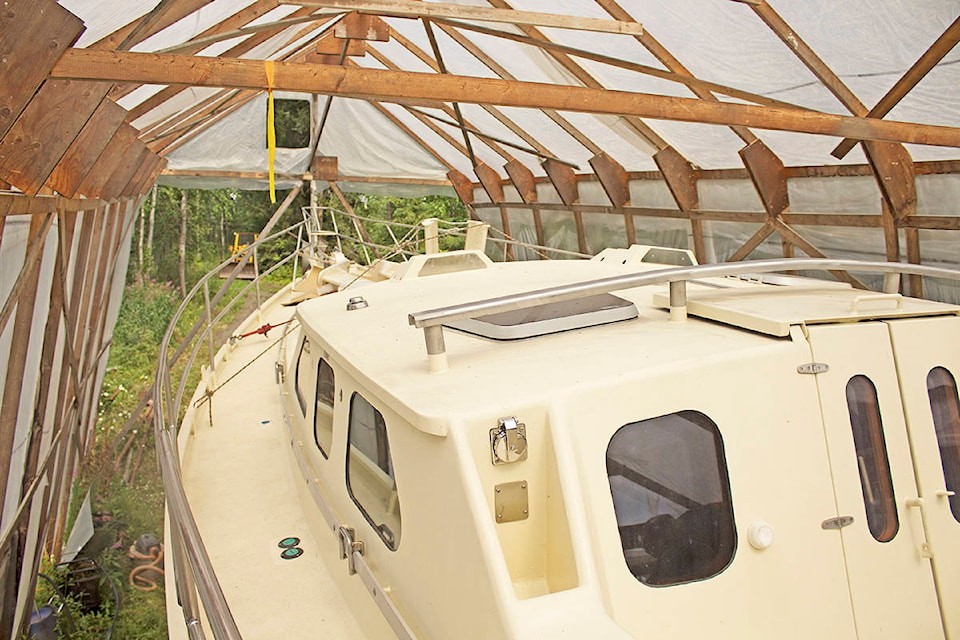Ah, for just one time I would take the Northwest Passage
To find the hand of Franklin reaching for the Beaufort Sea
Tracing one warm line through a land so wild and savage
And make a Northwest Passage to the sea
- Stan Rogers
Ron Smith, a Smithers area contractor, cannot recall precisely when he got it in his head that he wanted to sail the Northwest Passage, but for at least the past 12 years, he has been diligently working toward making it happen.
“I don’t know, I’ve always wanted to,” he said. “I’ve read lots of books on the Northwest Passage and it kind of piqued my interest.”
Prior to having the idea, he had no experience sailing, but he got himself a “learner boat” and has taught himself.
“I’ve sailed five or six years, but just local sailing,” he said.
He had also never refurbished a sailboat, but he found a hull of an old Bruce Roberts 45-foot cutter in Vancouver and had it hauled back to Smithers.
“I took out what was in there, steel fuel tanks, stainless steel water tanks, sandblasted, cut out the floors, sandblasted, painted, welded on tabs to attach wood to it, because there wasn’t much left,” he explained.
Also self-taught.
“You study, pick up books, read lots,” he said, adding his contracting experience came in handy.
Now the interior of the boat is beautifully appointed in cherry, mahogany and a little bit of teak and has all the modern conveniences — fridge, freezer, shower etc. — to make a three-month voyage through the passage as comfortable as possible.
Smith is ready to launch his “Obsession.”
Was it an obsession?
LAST WEEK: Friendship Centre Optimistic MMIWG mural will be painted this year
“I guess so, because my wife named it,” he said. “She’s had her moments, I guess.”
Smith was supposed to embark on the boat’s maiden voyage last week, but a problem with the truck that was meant to haul it delayed the trip.
He is hoping to put it in the water at Prince Rupert this week, however, and head down to Vancouver.
“There’s a mast I have to go look at and, if it works, I’ll put it on,” he said.
In lieu of a sail, the “Obsession” has a 70-horse diesel engine and Smith also has an outboard for backup.
“That’s the reason I’ve got the spare, just in case,” he said. “You always need a Plan B.”
NORTHWEST PASSAGE
Early explorers, of course, had no Plan B. When they set sail to find the mythical navigable trade route through the Canadian Arctic, it was basically a find it, perish or turn back proposition. Many attempts ended in disaster including the famous effort of Sir John Franklin in 1845.
While searching for Franklin in 1850, Irish Explorer Robert McClure discovered an icebound northern route and four years later, Scotsman John Rae explored a more southerly opening.
It was through that southern channel that the Norwegian explorer Roald Amundson became the first to successfully navigate from Greenland to Alaska in 1906.
MORE OUR TOWN:
Schell retires from wrestling with three national titles
A dairy and beef farm expands into cut flowers
The Norwegian Fridtjof Nansen tried a different approach in 1893 to 1896. He had a ship built called “Fram” (meaning forward) that was designed to be frozen into the Arctic ice sheet and float with it across the north pole. Since Nansen’s goal was to reach the north pole, when he realized the Fram was not going to make it, he and another member of the expedition set out on skis.
They made it to within four degrees of the pole but had to turn back and survived the winter in a Russian archipelago on walrus, polar bear and blubber until they were rescued by the British Jackson-Harmsworth Expedition. They arrived back in Norway just a few days before the “Fram.”
Until 2007, the ice pack in most years, with the notable exception of 1972, made the passage mostly unnavigable except to a few fortified icebreakers. With climate change, however, many are predicting the passage could become a viable shipping lane in the future.
SMITH EXPEDITION
Smith has no illusions that he is following in the legendary footsteps of the early explorers.
“There’s no comparison to what those guys went through and they were just flying by the seat of their pants,” he said.
In addition to declining sea ice — notably just last week the Milne Ice Shelf, the last fully intact ice shelf remaining in the Canadian Arctic, collapsed — he also has the advantage of 21st technology.
Still, he also recognizes that danger is always lurking.
“You can get lucky, but you can get unlucky too and get pinned in depending on which way the wind is blowing,” he said.
Smith hopes everything will fall into place and he will be able to set sail next summer. If not, it will be 2022, he said, but doesn’t know if he will be sailing solo or with someone else.
“There’s a couple of people who have expressed some interest, but we’ll see,” he said. “It doesn’t matter either way.”
editor@interior-news.com
Like us on Facebook and follow us on Twitter
